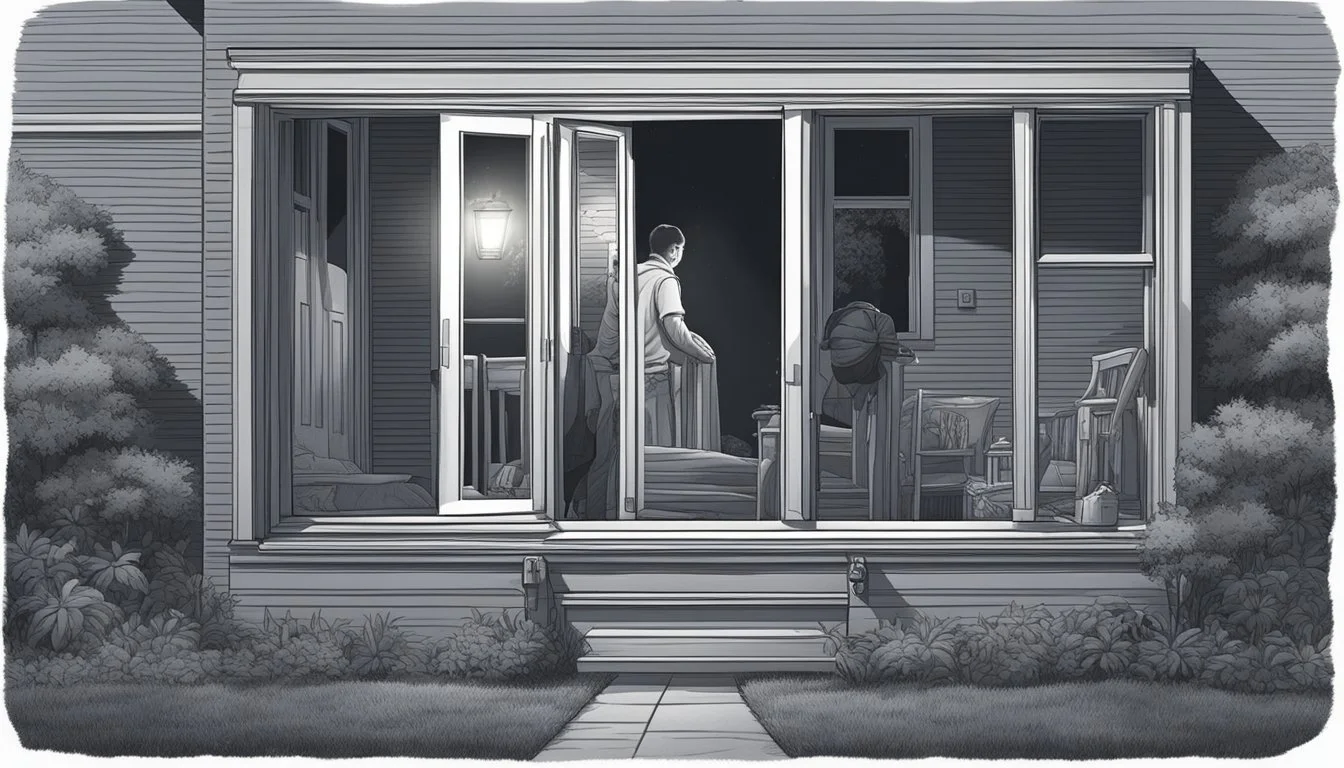Fact vs. Fiction: Separating Truth from Speculation in American Nightmare
Unraveling the Reality Behind Urban Legends
American Nightmare, a Netflix docuseries, recounts the harrowing true story of Denise Huskins and Aaron Quinn. The couple's lives were turned upside down when Huskins was kidnapped from Quinn's home in Vallejo, California, in 2015. What initially appeared to be a straightforward crime quickly became a complex web of accusations and disbelief.
The series presents a chilling reality: Huskins and Quinn's ordeal was not a fabrication, but a genuine nightmare that unfolded in their lives. Despite the seemingly far-fetched nature of their claims, the events depicted in American Nightmare are based on actual occurrences. The documentary explores how the couple faced skepticism from law enforcement and intense media scrutiny.
American Nightmare delves into the power of media narratives and their impact on public perception. The series raises important questions about the line between fact and fiction in true crime stories. It challenges viewers to examine their own biases and assumptions when confronted with sensational headlines and extraordinary claims.
Understanding 'American Nightmare'
"American Nightmare" blends true crime and media scrutiny, raising questions about reality versus perception. The Netflix docuseries explores a real-life kidnapping case that faced intense public skepticism.
Defining 'American Nightmare'
"American Nightmare" is a true crime docuseries on Netflix that examines the 2015 kidnapping of Denise Huskins. The series delves into the events surrounding her abduction and the subsequent media frenzy.
It highlights how law enforcement and the public initially doubted Huskins' story, comparing it to the film "Gone Girl." The docuseries presents firsthand accounts from Huskins and her partner, Aaron Quinn.
Scope of the True Crime Genre
True crime has gained immense popularity in recent years, with streaming platforms like Netflix producing numerous docuseries. These shows often focus on unsolved mysteries, controversial cases, or miscarriages of justice.
The genre aims to present real criminal events through interviews, archival footage, and reenactments. True crime docuseries frequently explore the impact of media coverage on investigations and public perception.
Some critics argue that the genre can sensationalize tragic events or retraumatize victims and their families.
American Nightmare and Fiction
"American Nightmare" challenges the line between fact and fiction in true crime storytelling. The series demonstrates how real events can seem implausible when compared to fictional narratives.
The public's initial skepticism of Huskins' kidnapping stemmed partly from its similarities to fictional plots. This phenomenon highlights the influence of media and entertainment on public perception of real-world events.
The docuseries serves as a reminder that truth can sometimes be stranger than fiction. It emphasizes the importance of critical thinking when consuming both news and entertainment media.
The Vallejo Kidnapping Case
The Vallejo kidnapping case shocked California in March 2015. It involved the abduction of Denise Huskins from her boyfriend Aaron Quinn's home, followed by a controversial police response that initially dismissed the incident as a hoax.
Chronology of the Denise Huskins Incident
On March 23, 2015, an intruder entered Aaron Quinn's Vallejo home. The masked man drugged the couple and kidnapped Denise Huskins. Quinn reported the incident to police the next day.
Huskins was held captive for 48 hours. During this time, her kidnapper sexually assaulted her. She was released near her family's home in Huntington Beach on March 25.
Initially, authorities were skeptical of Quinn's account. This skepticism intensified when Huskins reappeared, leading to public accusations of a hoax.
Profiles of Denise Huskins and Aaron Quinn
Denise Huskins, 29 at the time, worked as a physical therapist. Aaron Quinn, her boyfriend, was also in his late 20s. Both lived in Vallejo, California.
The couple faced intense public scrutiny following the kidnapping. Their ordeal didn't end with Huskins' return, as they had to defend themselves against accusations of fabricating the incident.
Despite the trauma, Huskins and Quinn stayed together. They later married and became advocates for victims of violent crimes.
Vallejo Police Department's Response
The Vallejo Police Department's handling of the case drew widespread criticism. They initially treated Quinn as a suspect, subjecting him to lengthy interrogations.
When Huskins reappeared, police publicly declared the kidnapping a hoax. This statement was made before a thorough investigation was conducted.
The department's premature conclusions caused additional trauma to Huskins and Quinn. It also hampered the investigation, allowing the real perpetrator to remain free for months before his eventual capture.
Fact vs. Fiction in Media Representation
Media portrayal of true crime cases often blurs the line between fact and fiction. This can lead to misconceptions and influence public perception in significant ways.
The 'Gone Girl' Comparison
The 'Gone Girl' comparison emerged as a popular narrative in media coverage of the Papini case. Some outlets drew parallels between Sherri Papini's disappearance and the plot of Gillian Flynn's novel. This fictional story involves a woman who stages her own kidnapping.
The comparison oversimplified the real-life case and potentially influenced public opinion. It introduced elements of fiction into the reporting of factual events. This blending of fact and fiction can complicate the public's understanding of complex criminal cases.
Media Influence on Public Perception
Media representation plays a crucial role in shaping public perception of criminal cases. News outlets often prioritize sensational aspects of a story to capture audience attention. This can lead to an emphasis on dramatic elements over factual accuracy.
In the Papini case, initial reports focused heavily on the mysterious circumstances of her disappearance. Some media outlets speculated about various scenarios before all facts were known. This rush to fill information gaps can result in the spread of unverified claims.
Public opinion can be swayed by the tone and framing of media coverage. Repeated exposure to certain narratives may influence how people interpret new information about a case.
Challenges of True Crime Reporting
True crime reporting faces unique challenges in separating fact from fiction. Journalists must balance the public's right to know with the need for accurate, ethical reporting. Incomplete information and ongoing investigations often complicate this task.
Reporters may face pressure to produce compelling stories quickly. This can lead to reliance on unofficial sources or speculation. In high-profile cases like Papini's, the demand for constant updates can result in premature conclusions.
Fact-checking becomes crucial in true crime reporting. Verified information should be clearly distinguished from unconfirmed details or theories. Responsible journalism requires patience and diligence to ensure accuracy in reporting complex criminal cases.
The True Crime Docuseries Impact
True crime docuseries have transformed how audiences engage with real-life criminal cases. These shows blend investigative journalism, storytelling, and visual media to present complex narratives.
Evolving Format of True Crime Docuseries
True crime docuseries have evolved from straightforward retellings to more nuanced explorations of cases. Modern series often incorporate multiple perspectives, including those of victims, investigators, and sometimes perpetrators. They utilize archival footage, reenactments, and expert interviews to create a comprehensive narrative.
These shows frequently challenge initial assumptions about cases, encouraging viewers to think critically. The format allows for in-depth examination of evidence and societal factors that may have influenced the crime or its investigation.
Netflix's Role in the Genre
Netflix has become a major player in the true crime genre, producing and distributing numerous popular docuseries. The platform's global reach has brought lesser-known cases to international attention.
Netflix's binge-watching model suits the true crime format, allowing viewers to consume complex narratives in one sitting. This immersive experience can lead to increased audience engagement and discussion.
The streaming giant has also invested in high-production values for these series, attracting top filmmakers and elevating the genre's overall quality.
Felicity Morris's Approach in 'American Nightmare'
Felicity Morris, known for "The Tinder Swindler," brings her distinctive style to "American Nightmare." The series focuses on the real-life case of Denise Huskins and Aaron Quinn, initially dubbed a "Gone Girl" scenario.
Morris employs a mix of interviews, interrogation footage, and audio recordings to present a multifaceted view of the case. This approach allows viewers to experience the confusion and disbelief surrounding the events as they unfolded.
The filmmaker's technique highlights the complexities of truth in criminal investigations and media reporting. Morris challenges viewers to confront their own biases and assumptions about crime narratives.
Realities of Home Invasion
Home invasions are serious crimes that can have devastating impacts on victims. They often involve violence or threats, leaving lasting psychological scars beyond any physical harm or property loss.
Statistics and Historical Context
Home invasions affect thousands of households annually in the United States. FBI data shows over 1 million burglaries occurred in 2019, with about 25% classified as home invasions where residents were present. These crimes peaked in the 1990s but have declined since then.
Historically, home invasions often targeted wealthy individuals for ransom or valuable possessions. Today, they occur across all socioeconomic groups. Drug-related home invasions have become more common in recent decades.
Victims are frequently chosen at random. However, some criminals conduct surveillance to identify vulnerable targets or homes likely to contain cash or valuables.
Psychological Trauma of Home Invasion
The psychological impact of home invasions can be severe and long-lasting. Victims often experience:
Acute stress disorder
Post-traumatic stress disorder (PTSD)
Anxiety and depression
Sleep disturbances and nightmares
Hypervigilance and startle responses
Many victims report feeling unsafe in their own homes for months or years after an incident. This can lead to social isolation and difficulty maintaining normal routines.
Children who experience home invasions are particularly vulnerable to trauma. They may develop separation anxiety or regress in developmental milestones.
Prevention and Awareness Strategies
While no home is completely immune, several strategies can reduce invasion risk:
Install sturdy doors, windows, and locks
Use alarm systems and exterior lighting
Trim bushes near entry points
Get to know neighbors and join neighborhood watch programs
Vary routines to avoid predictable patterns
Being aware of surroundings and trusting instincts about suspicious activity is crucial. If confronted by an intruder, experts advise complying with demands to minimize risk of violence.
Creating a family emergency plan can help household members respond quickly in a crisis. This should include escape routes, safe meeting places, and emergency contacts.
Dissecting the Myths
Myths and misconceptions often cloud high-profile criminal cases, distorting public perception and potentially impacting the pursuit of justice. Separating fact from fiction requires careful examination of evidence and expert analysis.
Common Misconceptions in Crime Cases
Criminal investigations frequently attract public interest, leading to widespread speculation. One common myth is the infallibility of eyewitness testimony. Research shows that human memory is fallible and can be influenced by various factors.
Another misconception is the "CSI effect," where jurors expect forensic evidence in every case due to popular TV shows. In reality, not all crimes leave behind usable forensic evidence.
The belief that false confessions are rare is also misleading. Psychological pressure, lengthy interrogations, and other factors can lead innocent individuals to confess to crimes they didn't commit.
The Role of Expert Testimonies
Expert witnesses play a crucial role in debunking myths and providing accurate information to the court. Forensic scientists, psychologists, and other specialists offer insights based on scientific research and professional experience.
These experts help interpret complex evidence, such as DNA analysis or ballistics reports. They also educate juries on topics like false confessions or the reliability of eyewitness identifications.
Expert testimonies can challenge popular misconceptions and provide a more nuanced understanding of criminal cases. However, it's important to note that experts can sometimes disagree, highlighting the complexity of certain issues.
How Myths Affect Justice
Myths and misconceptions can significantly impact the justice system. Preconceived notions may influence jurors' decisions, potentially leading to wrongful convictions or acquittals.
Media coverage often perpetuates myths, shaping public opinion before trials even begin. This can create challenges in selecting impartial jurors and maintaining fair proceedings.
Law enforcement may also be affected by myths, potentially leading to tunnel vision or overlooking alternative suspects. Overreliance on certain types of evidence, like confessions, can sometimes hinder thorough investigations.
Addressing these myths is crucial for ensuring fair trials. Educating the public, legal professionals, and law enforcement about common misconceptions can help create a more just and accurate criminal justice system.
The Aftermath and Lessons Learned
The American Nightmare case profoundly impacted the victims, law enforcement, and the Vallejo community. It led to significant changes in investigative procedures and support for survivors.
The Legal and Emotional Resolution
Bernadette Higgins, one of the survivors, played a crucial role in bringing the perpetrator to justice. Her testimony helped secure a conviction in 2015. The Vallejo Police Department faced scrutiny for their initial handling of the case.
The department implemented new protocols for responding to sexual assault reports. Survivors received expanded counseling and support services to address their trauma. Many victims found solace in support groups and therapy.
The Power of Retelling and Closure
Survivors sharing their stories proved instrumental in the healing process. Several wrote memoirs or participated in documentaries about their experiences. This allowed them to reclaim their narratives and educate the public.
Community events honoring the survivors' resilience became annual traditions. These gatherings fostered understanding and unity among Vallejo residents. Local schools incorporated lessons on consent and healthy relationships into their curricula.
Advancements in Crime Investigation
The case spurred technological improvements in evidence collection and analysis. DNA testing became more sophisticated, allowing for faster and more accurate results. The Vallejo Police Department invested in new training programs for detectives.
Improved interview techniques helped officers better support traumatized victims. Collaboration between law enforcement agencies increased, leading to more efficient information sharing. Digital forensics tools enhanced the ability to track suspects and corroborate victim statements.






